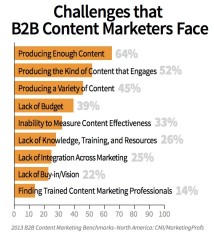By Tom Elgar
The Content Marketing Institute produces an extensive report each year, which includes a list of the biggest issues faced by content marketers.
In 2013 the biggest issue was producing content.
The second biggest issue was producing engaging content.
The third, variety of content.
The biggest issue with content marketing is, clearly, THE CONTENT.
There are many great tools to solve the issue of how to promote and manage your content: Hootsuite, TweetDeck, and the social networks themselves.
For most organizations though, as we can see, that is the least of their worries … as they have no content to manage and share.
At passle, we carried out our own research, and found more than 70 percent of companies cannot maintain ANY social presence, and only 13 percent can successfully run a business blog. The problem of creating content exists with the most professional of content marketers all the way through to the small business owner.
Inside Information
This is certainly the situation that presented itself at the last organization I worked at. I co-founded, with my brother Adam, a company called Serverside Group. We created a really nice-to-use Flash-based tool to let bank customers personalize their cards with pictures of their kids, pets, or anything else they loved. We had some great successes, and sold it to some of the biggest banks all over the world, such as Wells Fargo, Barclays, ANZ, ING, Fortis, and Capital One.
We had a strong, motivated team based in three continents with offices in London, New York, and Auckland. We were very web savvy, with a very visual product, and were the experts in our field.
We saw interesting developments in our industry all the time. We monitored the marketing efforts of most of the world’s banks on pretty much a daily basis: Their moves in social media, their ideas about customer engagement, sport marketing, all sorts.
Fail Business Blog
I say all this simply to point out that we were in a great spot to create some really interesting marketing content, for ourselves, and for the industry.
Ultimately, our business blog was designed to achieve two things:
- Be a resource for the industry. We had a vast amount of focused knowledge on what these banks were doing, where, and why… and we had a unique take on that information. It would, without doubt, have been valuable to bank marketers all over the world as a springboard for ideas.
- Show that we knew our stuff. In the content world, people often talk of blogging as a method to create ‘thought leadership.’ We didn’t see ourselves in that light, but we did know a lot about the industry. We wanted our blog to get our name and product out, and prove we really cared: Cared about the market, cared about our product, as well as security and uptimes. We wanted to show we were a reliable and thoughtful organization.
That would have been hugely valuable to us. And to others. But it didn’t happen.
Actually what happened was we wrote a post or two and then realized we weren’t going to be able to maintain the business blog. A good PR professional was hired to help us. He wrote some quite amusing, but pretty generic bits. Certainly not the content we could have – and should have – been creating. After a while, he started to do other work for us. The business blog link just sat on our website, looking sad and lonely.
Eventually the new marketing director took control, and one day he walked our business blog quietly off into the snow and shot it.
It seems this is an all too familiar story with businesses everywhere. People might be experts in their field, but for many reasons – lack of time or resources, waning motivation, staffing issues – just cannot display that expertise to the world via their business blog.
Blogging takes a ton of work. It requires a consistent flow of high quality content, but the returns via reach and word of mouth marketing make the time and effort worthwhile. That said, your blog will die if you don’t pay it the time and attention it deserves. Don’t let that happen to you.
